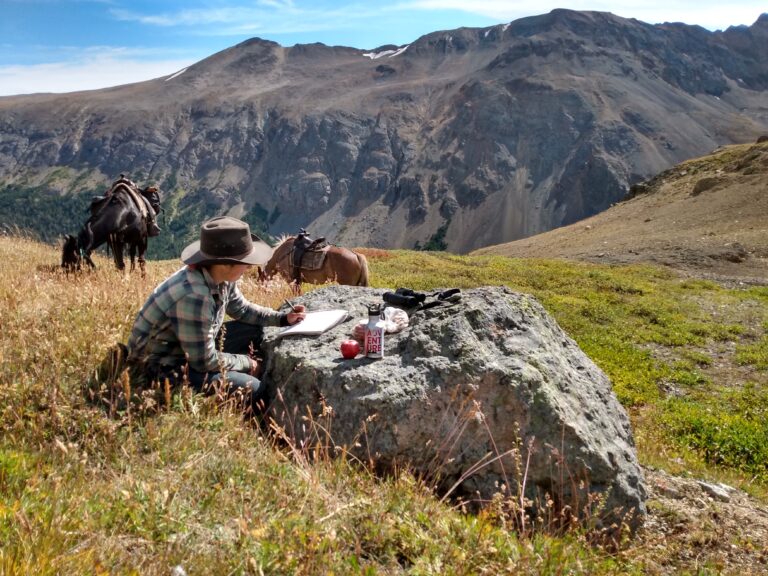Doing the Impossible Again

What does it take to write a book? There’s a lot of answers you could give. When you were in school, you were probably taught to write a beginning, middle and end. You might say you need a set plan so you can build up to the climax and create a plot-twist ending. You might think you need an English degree, a publishing contract, five years of writing and editing.
Really, there are three things you need.
The idea.
The belief.
The ability to let go and let your story flow through you onto the page.
So let’s explore each of those in turn.
Where did the idea come from for my book? Well, like with all good ideas, it came both from many little events and in a flash of inspiration. The inspiration came in a book store in Alaska. I sat down with a blank notebook and in a few hours had mapped out a first draft of all my chapters. I’d been struggling to find where to end my book, but it suddenly seemed so obvious: the end of my tourist visa in October, my first six month at the ranch.
And what about those little events? One was an evolution in my writing style. My journal had previously been a list of events. During my first summer at the ranch it became a story, full of emotion, my evolution and that of my fellow community partners. Another was the countless blog stories I was writing for our Trails To Empowerment website. These were ready-made stories ready to slot into my book. The biggest of these events was Kevan suggesting I write a book from my journal. Well, I thought that was crazy. I’d always thought about being an author, but didn’t know how to make that a reality.
That’s where the belief comes in. Belief can come in many different ways. It can come from other people, but it’s most important that it comes from you. If you don’t believe in your book, who else will? Kevan was the first person to believe in my book – by suggesting I write it, by asking how I was progressing with it. But he wasn’t the only one. I searched for editors on the Editors Guild and sent out emails to about twenty of them. Ten of them believed enough to reply – but they did think my four month deadline was “a little unrealistic”. In other words, crazy and impossible. So I worked more with the three or four editors who weren’t put off by the deadline and found one who was enthusiastic to take on my project. She was my second believer.
My mom, back in the UK, was another believer. Initially, she also had her doubts about that four month deadline, but she proof-read my entire manuscript and helped me make that deadline happen. My other believers were all my community partners at the ranch. Dale and Manon helped with proof-reading. Fenja helped me with the graphic design – something I didn’t know anything about before. The evening before I sent my manuscript to the printer to print the proof copy, Fenja taught me how to use InDesign and I worked on the cover and photo pages until 11pm. The printers I chose were another believer, especially Craig who I called at least ten times with questions he was always happy to answer.
And I had to be my own believer. I could have the whole world believing in my book, but if I didn’t believe too, I’d never have written it. I wouldn’t have stayed up late every night alone in the office, typing, editing and re-typing. I’d have listened to the naysayers who told me I couldn’t write, edit and print a book in four months. But I believed in my idea, I believed in my story and I believed in my own ability to translate the thoughts and emotions in my mind into words.
But how does a story write itself? If you plan and analyze every sentence and paragraph for structure, for literary devices, you’re going to forget about the story. The story is where the magic happens. On Writing by Stephen King was a book I read while writing my book. He explains how the writing process is like carefully extracting a fossil from the ground. Break it and the idea is lost. Keep it intact and you have something amazing. If you work too hard on your story, if you think you are writing it, if you are thinking period, you might get a book, but I don’t know if it’ll be a story. By disconnecting yourself from thinking, by losing yourself in the idea until the idea is in charge and you are simply its typist, you will create a story that brings through all the emotion that really makes the words on the page come to life, that make the reader connect, understand and have an emotive reaction themselves.
Stephen King says to write the first draft of your book with the door closed, the second with the door open. That means you need to be alone to write that first draft. You need to not ask for other peoples ideas, because then you’re getting caught up in the realm of thought again. The second draft is where you invite others in to see if you’ve communicated your idea so others can follow and understand.
But how do you let go of thought and let the story flow through you? Well, you need the idea first. And not just a fleeting idea. The idea needs to be so strong it’s practically bursting out of you. You become obsessed with that idea, you’re making notes of your visions, you find sentences, paragraphs or even whole chapters come to you fully formed. They don’t need editing, they are just perfect. Write these down before you forget them. This is a flash of your story writing itself. This is a glimpse of the “zone” you want to get into. The idea needs to be so real to you that you can live it. For me, this was easy, I was writing about my own experiences and evolution. If you’re writing a work of fiction, you need to make friends with your characters. Talk to them, find out what they like and dislike, this will bring them to life. If those characters aren’t real in your mind, they won’t feel real to your reader. Stephen King says a writer needs to spend four to six hours a day reading and writing. This is true. The more you write, the easier it is to get into the “zone”, which is letting the story flow through you, feeling the energy. If you’re immersed in your story all day, every day, it’s easy to create.
You know you are in the zone because nothing else matters but the story. When I was writing, I forgot to eat dinner, I could write until 10pm then get up at 6am to write some more. It didn’t matter that my fingers were cramping from typing. Once I was out of feeling the energy, I could reflect on taking care of myself. I realized my best work came in the evening, not the morning. The evening was when it was easiest to feel the energy. I felt full of white Light, excited for what was coming next – because I didn’t feel like I was writing it. I felt powerful. I felt that every word that came was the right word. It felt like magic, how could a story have its own entity, its own power? But it did and that felt like everything was right in the world, because all there was in the world was my story.
And don’t get caught up in chapter titles, spelling, “there” or “their”, where your paragraphs need to break, the exact perfect word. Doing this brings you back to thought. These elements are for the editing process. And the less you break your energy flow by returning to thought, the more those perfect words will come by themselves.
Letting the story write itself might seem contradictory to writing down ideas and a chapter plan. But the planning process is just a vehicle to get you into the zone. It’s flexible. Just because you planned on having sixteen chapters where set events happen in each one, it doesn’t mean that’s how your finished book will look. The plan is just a way to immerse you in your story, until it’s ready to write itself. Chapter Two of my book was planned to describe my travels in Europe before I came to Canada. But as I wrote it, one of those travelling experiences took over, a transformational experience I had while visiting the Berlin Wall. That became the main part of that chapter. And then Chapters One and Two became merged together. I’d chosen all the quotes I’d wanted for my chapter epigraphs before I started writing. When each chapter was written at the first draft stage, I changed many of those quotes to fit the story that had written itself, not the plan I’d had.
Like writing my book, I’d had a rough plan for this blog story. It had come to me in a flash of inspiration – a vision – and I’d made a page of notes. Maybe half those notes made it into this story. This blog story is mostly created during the writing progress, something I had to do alone. Once the first draft was written, I shared it with my community partners who could edit and offer suggestions. But the idea had to be there first. I believed in that idea and gave it the opportunity to write itself, to express itself as felt right in the moment.
This is the story of creating my story, a book I created in only three months, a whole month before my four month deadline, doing the impossible one more time. The Mountain in My Mind is a book about my transformational journey, how I climbed my own personal mountain, achieved self-actualization and became empowered. But that wasn’t the end of my journey. It was only the beginning. When I stood on my mountain top, I realized it was only the beginning of a ridge that extended all the way to the horizon. There were ups and downs all the way along that ridge.
And now I’m walking that ridge, I’m learning the horizon is always the same distance away. I face and overcome a challenge or celebrate a major success, but there are still the same number of peaks and troughs ahead of me. That’s because the journey of personal growth lasts a life time, but you can only ever see so far ahead. Maybe if you have better “future vision” you’ll see further, but there will always be more beyond what you see.
Since I wrote The Mountain in My Mind, I found spiritual growth. I experienced a massive personal evolution. I feel the energy I felt when the idea of my book flowed through me every day now. That is the energy of creation, the Light, the Universe, it is being truly empowered, being connected to the world around us. It is positivity, an oxytocin high, presence in the moment, acceptance, peace, excitement, love, joy. This is the greatest energy and power there is. Writing my book was my first glimpse of living in this world. Now, it is my world. And it is something I want to share with every person and animal I meet, everything I do, every experience I have. I want to share positive energy. Because when positivity meets positivity, the reaction is exponential. If you’re positivity is a 10 out of 10 and you meet some one who is also a 10, the equation isn’t 10+10=20, it is 10×10=100. The same works if you’re positivity is only 0, which isn’t positivity at all. 0x0=0, you gain nothing.
The idea for my next book is starting to come together. The energy equations above might be a part of that book or another idea might surpass it. Only letting the story write itself will be the judge of that.
And now you know the three things you need to write a book. It all comes from the idea. If you’re not obsessed with the idea, nothing else matters. If you don’t believe in your idea, it will only ever be an idea. If you can’t let go of thought and let the idea’s energy flow through you, you’ll have a mechanical text, not a story to share.
Charlie, UK



